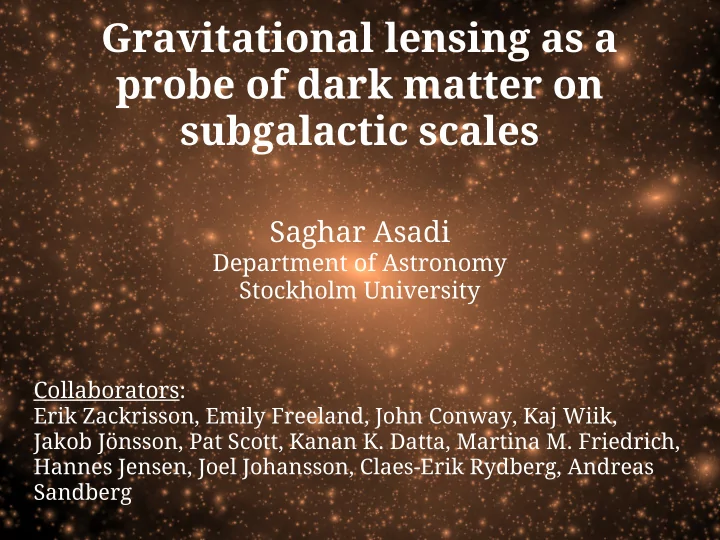

Gravitational lensing as a probe of dark matter on subgalactic scales Saghar Asadi Department of Astronomy Stockholm University Collaborators : Erik Zackrisson, Emily Freeland, John Conway, Kaj Wiik, Jakob Jönsson, Pat Scott, Kanan K. Datta, Martina M. Friedrich, Hannes Jensen, Joel Johansson, Claes-Erik Rydberg, Andreas Sandberg
Dark matter halos What they look like in Typical textbook illustration actual N-body simulations
These subhalos are troublesome! • Long-standing problem Too few satellite galaxies compared to subhalos in CDM simulations (Moore et al. 99, Klypin et al. 99) • Possible solutions – Vanilla CDM not correct! Try warm, fuzzy, light, self-interacting or super- WIMPy dark matter… Large numbers of – Star formation quenched in all but the most massive completely dark subhalos subhalos awaiting detection!
Hunting for the dark ● If CDM is WIMPs Subhalos detectable with Fermi due to WIMP sefl-annihilation No clear-cut detections so far... ● Subhalos may also be detectable through gravitational lensing effects – regardless of the microphysics of the dark matter particles
The lensing situation Zackrisson & Riehm (2009) Galaxy with dark matter halo at z≈0.5 Light source Observer at z ≈ 1-2 Multiple images Strong lensing (a.k.a. macrolensing)
Resolution effects Small-scale distortions get washed out by poor observational resolution Detecting low-mass subhalos requires very high angular resolution Problem: You cannot have both large sources and great resolution! ● Hubble Space Telescope 0.1″ resolution ~ 1 kpc sources (galaxies, stellar continuum) ● ALMA (with 10 km baseline) 0.01″ resolution ~ 100 pc sources (galaxies, dust contiuum, CO) ● European VLBI Network (EVN) 0.0003″ (0.3 milliarcsecond) ~ 1-10 pc sources (AGN jets)
Simulations 86 GHz 22 GHz 8.4 GHz ALMA + global 3-mm array European VLBI Network (EVN) EVN + VLBA
Larger source area Higher chance of detection
Detections so far Vegetti et al. (2012, Nature): HST observations Smooth model Residual Data 10 8 M solar subhalo Weird: Detections give tentative evidence for more substructure than predicted by CDM, and a flatter subhalo mass function
Other supporting observations? “The amount of substructure in the central regions of the Aquarius halos is insufficient to explain the observed frequency of violations of the cusp-caustic relation.” (Xu et al. 2009) fold cusp
N-body simulations vs. detections ● Galactic subhalo mass fucntion: Aquarius N-body too steep?! simulation : (Springel et al. 2008) ● Relative substructure mass fraction: Aquarius N-body simulation : too low?! (Springel et al. 2008)
Detectability limits 1. Compact dark objects (IMBHs & UCMHs) 2. “Standard” CDM subhalos (NFWs) Negligibly small ● Low number density probability of proper ● Shallow inner density profile alignment
EVN observations (Feb 2013) Metcalf (2002) Rusin et al. (2002), Metcalf (2002): B1152+199 Anomalous bending in lensed AGN jet VLBA observations @ 5 GHz (3.6 × 1.9 mas beam)
Our observations: 0.3 mas resolution @ 22 GHz First robust detection of millilensing? Team: Erik Zackrisson (PI), Saghar Asadi, Emily Freeland, Hannes Jensen, John Conway, Kaj Wiik
B1152+199 (Expectations) IMBH 10 5 M solar UCMH 10 6 M solar NFW 10 8 M solar point mass ρ ~ r -2.5 ρ ~ r -1
Recommend
More recommend